
Wood carvers are masters of transforming raw timber into breathtaking art, and one of their most powerful tools is the natural texture of the wood itself. By carefully studying the grain patterns, density variations, and organic imperfections, skilled artisans turn these features into intentional design elements that bring depth and character to their work.
The direction of the grain becomes a guide for carving strokes, allowing the wood's natural lines to complement the sculpture's form. Carvers often highlight contrasting textures—smooth surfaces against rough-hewn areas—to create visual interest and tactile appeal. Knots and burls, rather than being flaws, are strategically incorporated as focal points that tell the story of the tree's life.
Seasoned craftsmen use specialized techniques like relief carving to play with light and shadow across textured surfaces, or chip carving to create intricate geometric patterns that interact with the wood's underlying structure. The final finish—whether left natural, stained, or polished—is always chosen to enhance rather than conceal the wood's inherent beauty.
This harmonious relationship between artist and material results in pieces where the wood doesn't just serve as a medium, but becomes an active participant in the artistic expression—each texture variation adding uniqueness and organic vitality to the finished work.

